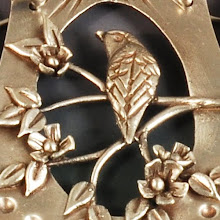After finishing up one week at Jewelry Studies International, my head is spinning with ideas. On the fourth day, we finished up the flared ring and started another. Although I originally sized my outer ring so that it was free to spin, I decided that I really didn't like it (perhaps it moved too much). So I stretched the flared band out enough to tighten against the outer ring and lock it into place, which was the original design anyway (did you know that spinner rings are patented?). The protected part of the flared band has a deep black patina, while the edge, outer ring, and inside all have a bright, burnished polish.
 |
| flared capture ring and band with fused jump rings and granulations |
The final project of the rings class was a complex fused jump ring and granulation project, which required more finesse than I yet have to get the rings all perfectly shaped and spaced.
 |
| granulation ring |
Since we had a final day for finishing and our own projects, I decided to tackle the jump rings again, but forgot the sequence in my quest to prove that I could get a ring formed and fused in record time. So I took it as a design opportunity to make a different ring, with two wire outer rings capturing a single row of granules (all hand made, by the way, not purchased).
 |
| file silver clay bird fused to Argentium ring shank |
Finally, part of the reason I have undertaken these classes is to explore the possibilities of combining fabricated parts made from Argentium with metal clay components. One evening after class, I sculpted a small flying bird in fine silver. I squared my double round wire ring and cut a corresponding double trench in the back of the bird with a ball bur. Ronda tacked it into position with the laser welder to avoid a balancing issue, and I fused the two together. SO EASY! That's why my head is spinning with ideas. Many of these rings are destined for future combination with metal clay. I'll be experimenting with fusing sterling clay with Argentium, as well as with embedding Argentium components into clay and then carbon firing. So many possibilities await.

























